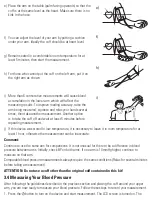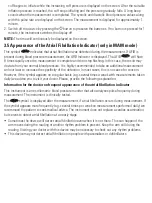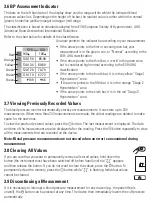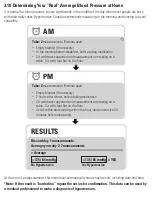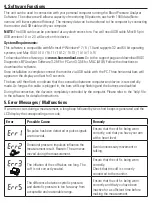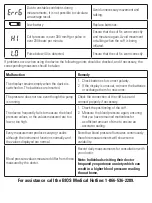
• If you have been diagnosed with a severe arrhythmia or irregular heartbeat, vascular constriction,
liver disorders, or diabetes, have a cardiac pacemaker, or are pregnant, measurements made with this
instrument should only be evaluated after a consultation with your doctor.
• Take care while handling the batteries in the device. Incorrect usage may cause battery fluid leakage.
To prevent such accidents, refer to the following instructions:
— Insert batteries with the correct polarity.
— Turn off power after use. Remove and store the batteries if you are not planning to use the device
for an extended period of time.
—
Do not
mix different types, brands, or size of batteries. This may cause damage to the product.
—
Do not
mix old and new batteries.
— Remove batteries and dispose of them according to the proper regulations in your area.
—
Do not
disassemble batteries or expose them to heat or fire.
—
Do not
short-circuit the batteries.
—
Do not
use rechargeable batteries.
1.2B Care of the Device
For prolonged life of your blood pressure monitor, note the following instructions:
•
Do not
drop or bang the unit. Prevent sudden jerks, jars, or shocks to the device to prevent damage.
•
Do not
insert any foreign objects in any device openings or vents.
•
Do not
disassemble the unit.
• If the unit has been stored at very low or freezing temperatures, allow to reach room temperature
before using it.
•
Do not
store the unit in direct sunlight, high humidity, or in places with a lot of dust.
• Clean the device with a soft dry cloth. Do not use gasoline, thinner or similar solvents. Carefully
remove spots on the cuff with a damp cloth and soap. Do not wash the cuff.
•
Do not
use the device if you think it is damaged or if anything appears unusual.
• Ensure that children do not use this device unsupervised;some parts are small enough to be
swallowed.
• Using the unit in the immediate vicinity of mobile phones, microwave appliances or other devices with
strong electromagnetic fields may result in impaired functioning.
•
Do not
use this device close to strong electromagnetic fields, such as mobile telephones or radio
installations. Keep a distance from such devices when using this unit.
1.2C Comparing Readings to Other Blood Pressure Devices
Many questions arise when two blood pressure devices are compared in an effort to check accuracy. An
accurate comparison requires repeatable measurements under the same conditions to “reference device”
with known accuracy. Significant time is required to reduce naturally occurring blood pressure variability
during the test. The subject should be seated comfortably with feet flat on the floor, and have rested for 5
minutes before the first reading to allow blood pressure levels to stabilize.
The patients back, elbow and forearm should be supported, and the middle of the cuff should be at the
level of the right atrium. There should be no talking or moving during the measurement and if comparing
to an aneroid gauge or mercury column, observers should avoid parallax and be careful not to round
measurements.

















